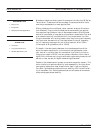
Calibrating for a
Measurement
Let us assume that we want to correct for three errors in the reflection
measurement: source match, directivity, and tracking. We accomplish
this using three standards.
Shorts are the easiest to visualize. They totally reflect all of the inci
-
dent RF energy output at a precise phase. The terms zero-ohms imped
-
ance, voltage null, and 180° phase all define an RF Short.
Opens are similar to Shorts, but their response is more complex. The
terms voltage maximum, infinite impedance, and 0° phase all define a
perfect Open. A perfect Open, however, is only a concept. In reality
Opens always have a small fringing capacitance.
To account for the fact that the Open will not predictably reflect im
-
pedance at an exact 0° phase reference, we alter its response using co
-
efficients that accurately characterize the fringing capacitance. The co
-
efficients are different for each coaxial line size, since each size has a
different fringing capacitance. To maximize accuracy, ensure that
these coefficients are installed prior to the calibration (Menu U3).
As Opens and Shorts provide two references for a full reflection, Z
0
ter-
minations provide a zero-reflection reference.
Ideal Z
0
terminations must consist of two parts, a perfect connector
and an infinite-length perfect transmission line that absorbs all of the
RF energy that enters it (no reflections).
Infinite length transmission lines are unwieldy at best, so you must
use less-than-ideal terminations. For calibration purposes there are
two common types: broadband loads and sliding terminations.
37xxxE OM 7-9
MEASUREMENT CALIBRATION DISCUSSION
CALIBRATING FOR A REFLECTION
MEASUREMENT USES THREE
STANDARDS:
·
Short
·
Open
·
Termination
IDEAL TERMINATIONS
·
Reflectionless
·
Perfect Connector
·
Infinite-Length, Dimensionally Ex-
act, Reflectionless Transmission
Line
PRACTICAL Zo TERMINATIONS
·
Broadband Load
·
Sliding Termination


















